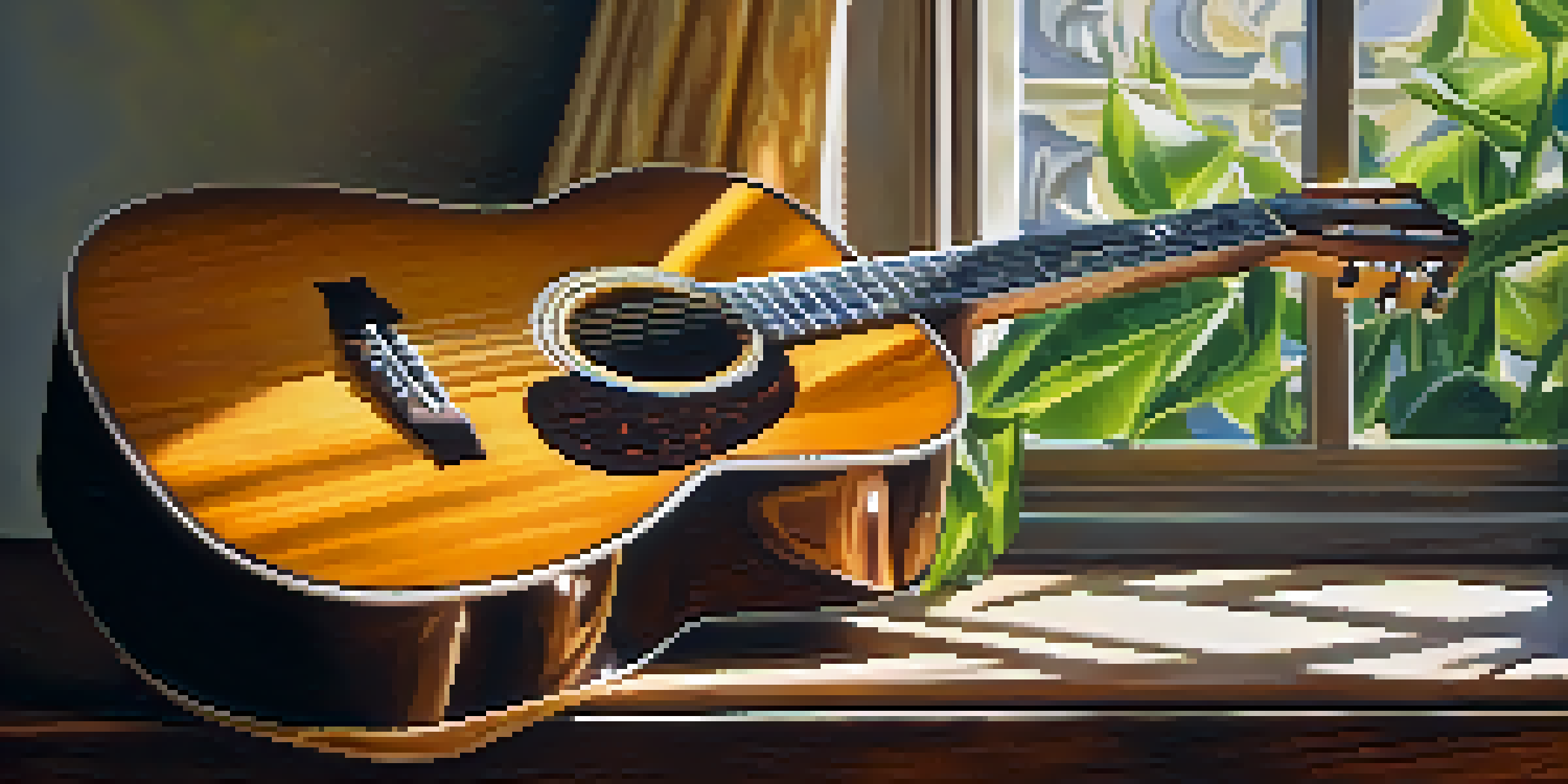Utilizing Open Tunings for Creative Guitar Compositions

Understanding Open Tunings and Their Appeal
Open tunings are an alternative way to tune your guitar, where the strings are adjusted to create a specific chord when strummed open. This approach unlocks a world of sonic possibilities, allowing you to explore unique sounds and chord voicings that standard tuning simply can't offer. Imagine strumming a few chords and instantly feeling the vibe of a new song take shape—this is the magic of open tunings.
Music is the shorthand of emotion.
Many iconic guitarists, such as Keith Richards and Joni Mitchell, have relied on open tunings to craft their signature sounds. These tunings not only provide a fresh palette for melodies but also encourage experimentation, making them a favorite among songwriters looking to break free from traditional chord progressions. Think of open tunings as a new lens through which to view your guitar.
By using open tunings, you can discover new relationships between notes and chords. This can lead to innovative ideas that might not have surfaced in standard tuning. It’s like finding hidden treasure in familiar territory, giving you a renewed sense of creativity.
Exploring Popular Open Tuning Variations
There are numerous open tuning variations, each offering its own flavor and character. Some of the most popular include Open D (D-A-D-F#-A-D) and Open G (D-G-D-G-B-D). Each of these tunings has a distinct resonance that can inspire different musical ideas and styles.

For instance, Open D tuning gives a rich, full-bodied sound that works beautifully for blues and folk music. Conversely, Open G tuning often lends itself well to rock and slide guitar, making it a favorite for artists looking to add a gritty edge to their compositions. Think about the vibe you want to create, and choose a tuning that aligns with your musical vision.
Unlock Creativity with Open Tunings
Open tunings transform familiar chord progressions into unique sounds, inspiring fresh songwriting ideas.
Experimenting with these variations can lead to exciting breakthroughs in your songwriting. You might find that a simple change in tuning can transform a mundane riff into something extraordinary, sparking new creative directions you hadn't considered.
Techniques for Playing in Open Tunings
Playing in open tunings may feel unfamiliar at first, but with practice, you can master the unique techniques they require. One effective method is to focus on fingerpicking, as it allows you to highlight the resonant qualities of the open strings while creating intricate patterns. This technique can elevate your compositions and add depth to your sound.
The guitar is a miniature orchestra in itself.
Slide guitar is another popular technique that shines in open tunings. By using a slide, you can achieve smooth transitions between notes, creating a fluid sound that resonates with audiences. Think of it as painting with sound, where the slide acts as your brush to create beautiful, sweeping strokes.
Lastly, don't shy away from experimenting with dynamics and rhythm. Open tunings provide a platform for creative strumming patterns and percussive playing. This not only enhances the overall texture of your music but also invites listeners to engage more deeply with your compositions.
Crafting Melodies with Open Tunings
Melody creation in open tunings can feel like a breath of fresh air. The unique chord structures often lead to unexpected melodic ideas, allowing you to explore new emotional landscapes. You might find that a simple melody can evoke feelings you never knew you could express through your guitar.
One effective approach is to utilize the open strings as a foundation for your melodies. As you play, let the resonance of the open strings guide your finger placements, creating a natural flow that enhances the overall sound. This allows for a seamless connection between melody and harmony, enriching your compositions.
Explore Various Tuning Techniques
Techniques like fingerpicking and slide guitar enhance the resonant qualities of open tunings, adding depth to your music.
Don't forget to incorporate elements like bends and hammer-ons. These techniques can add expressiveness and character to your melodies, making them more engaging and memorable. Think of your melody as a story, and let the open tuning be the backdrop that brings it to life.
Using Open Tunings for Songwriting
Songwriting in open tunings can be a liberating experience. The freedom of unique chord voicings often inspires new lyrical ideas and themes, making the songwriting process feel more organic. As you strum through different chords, you may find lyrics flowing more naturally, reflecting the emotions the music evokes.
Consider starting with a simple chord progression in an open tuning and letting it guide your lyrics. This approach can lead to a more cohesive relationship between your music and words, enhancing the overall impact of your song. It’s like having a conversation with your instrument, where both the melody and lyrics inform each other.
Additionally, open tunings can encourage improvisation, allowing you to play around with various ideas that might not have emerged in standard tuning. This can lead to spontaneous bursts of creativity, resulting in songs that feel fresh and authentic. Embrace the process and allow your open tuning journey to shape your songwriting.
Collaborating with Other Musicians in Open Tunings
Collaborating with other musicians in open tunings can lead to exciting musical discoveries. When you play with someone who uses a different tuning, it can create a rich tapestry of sound, blending various textures and styles. This diversity allows for a dynamic musical exchange that can elevate your compositions to new heights.
One effective collaboration method is to create a ‘call and response’ dynamic, where one musician plays a phrase and the other responds, creatively building off the initial idea. This interaction can foster innovation and spark inspiration, resulting in a piece that feels both cohesive and exploratory.
Collaborate for Unique Soundscapes
Working with other musicians in different tunings creates rich, dynamic interactions that elevate your compositions.
Don't hesitate to experiment with layering parts in different tunings. This can lead to intriguing harmonic relationships and a fuller sound. It's like piecing together a puzzle, where each musician's contributions fit perfectly to create a beautiful, collaborative masterpiece.
Final Thoughts: Embracing the Journey of Open Tunings
Embracing open tunings is about more than just changing the way you tune your guitar; it's about opening your mind to new creative possibilities. Each tuning offers a distinct sound that can inspire you to break away from your typical routines and approach compositions with fresh eyes. Remember, the journey is just as important as the destination.
As you experiment with different tunings, allow yourself the freedom to make mistakes and explore various styles. Sometimes the most unexpected sounds can lead to the most memorable compositions. Think of your guitar as a canvas—every tuning is another color, waiting to be painted on.

So, pick up your guitar, try a new tuning, and see where the music takes you. The beauty of open tunings lies in their ability to inspire and evolve your sound, making every strum a step towards your next creative breakthrough.